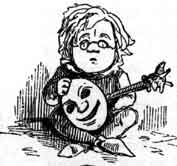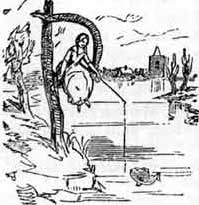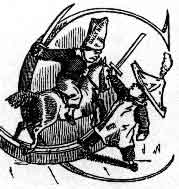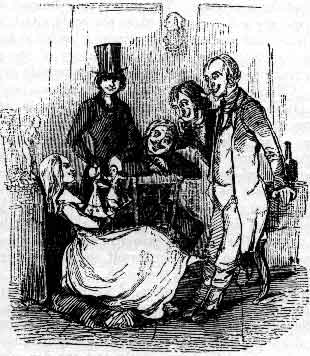|
THACKERAY'S ILLUSTRATIONS FOR VANITY FAIR
Thackeray, who intended his illustrations to be an
integral part of the novel, filled it with drawings. The first letter
of every chapter is incorporated into a drawing; almost every chapter
includes a full-page drawing with an inscription at the bottom and one
or more drawings of various sizes.The drawings supplement or complement
the text in various ways. He was not entirely pleased with the final
result in print. Firstly, he regarded them as "tenth or twentieth rate
performances having a meaning perhaps but a ludicrous bad news of
execution." Secondly, the methods of reproducing graphics in the
nineteenth century tended to produce less accurate renderings than
modern methods.
I have included several drawings to illustrate some of the ways that
they contribute to the meaning of the novel.
Example 1
 Thackeray's
drawing of himself holding a mask and a fool's scepter is relevant to
the discussion of the narrator: is
Thackeray to be equated with the narrator and the narrator's views, or
is Thackeray the deliberate creator of a persona whom we call the
narrator? Does the mask suggest the possibility of changing guises or
identities? (A poor copy of this drawing appears on the title page of
your text.) Thackeray's
drawing of himself holding a mask and a fool's scepter is relevant to
the discussion of the narrator: is
Thackeray to be equated with the narrator and the narrator's views, or
is Thackeray the deliberate creator of a persona whom we call the
narrator? Does the mask suggest the possibility of changing guises or
identities? (A poor copy of this drawing appears on the title page of
your text.)
Example 2
 The meaning of the
initial drawing for Chapter 4 is obvious; Becky is angling for a fat
fish, Jos. There is irony in the fact that Jos, who distinguishes
himself by how much he eats and drinks, is himself in danger of being
caught and eaten by Becky. Continuing the fish metaphor, Mr. Sedley
tells his wife, "But mark my words, the first woman who fishes for him,
hooks him" (43). Besides flattering Jos with references to his
knowledge of foods, Becky lures Jos by knitting a green purse, the
green perhaps suggesting Becky's envy
of the Sedley's affluence; she shyly implies that she is making it for
him. Though Becky is in a natural setting in the drawing, Thackeray's
emphasis on society is maintained by the buildings in the background. The meaning of the
initial drawing for Chapter 4 is obvious; Becky is angling for a fat
fish, Jos. There is irony in the fact that Jos, who distinguishes
himself by how much he eats and drinks, is himself in danger of being
caught and eaten by Becky. Continuing the fish metaphor, Mr. Sedley
tells his wife, "But mark my words, the first woman who fishes for him,
hooks him" (43). Besides flattering Jos with references to his
knowledge of foods, Becky lures Jos by knitting a green purse, the
green perhaps suggesting Becky's envy
of the Sedley's affluence; she shyly implies that she is making it for
him. Though Becky is in a natural setting in the drawing, Thackeray's
emphasis on society is maintained by the buildings in the background.

Example 3
The initial drawing for Chapter 5 deflates the "epic"
fight between Cuff and Dobbin. The boys carry wooden swords, wear paper
hats, and Cuff rides a rocking horse. Interestingly, in a novel which
deals with the Battle of Waterloo, a watershed in European history,
their fight is one of the most violent actions presented.
Example 4
Some drawings are less flattering to Becky than the text
is. The drawing which most affects our view of Becky represents Becky
as Clytemnestra at the end of the book. I will discuss it after you
have finished the novel. The point I am making can readily be seen in
the drawing of Becky using the dolls as puppets to mimic Miss Pinkerton
and her sister. Note Becky's malicious expression. The posture and
dress of the men is somewhat disreputable. Does the picture also
suggest why, as an adult, she gets along so well with men? why the
Bohemian life appeals to her? and why she enjoys being with people?

Example 5
Thackeray uses a drawing to support the reason he offers
for using contemporary dress for his characters, even though the novel
is set a generation earlier, when styles were quite different:
It was the author's intention, faithful to
history, to depict all the characters of this tale in their proper
costume, as they wore them at the commencement of this century. But
when I remember the appearance of people in those days, and that an
officer and lady were actually habited like this–

I have not the heart to disfigure my heroes and
heroines by costumes so hideous; and have, on the contrary, engaged a
model of rank dressed according to the present fashion.
|

